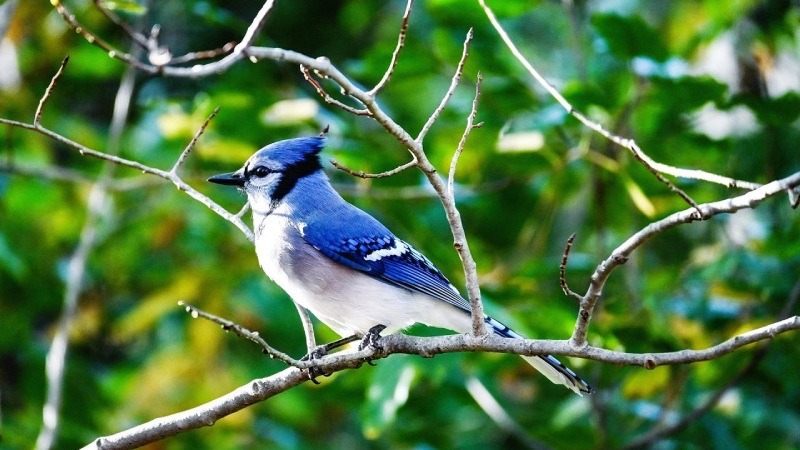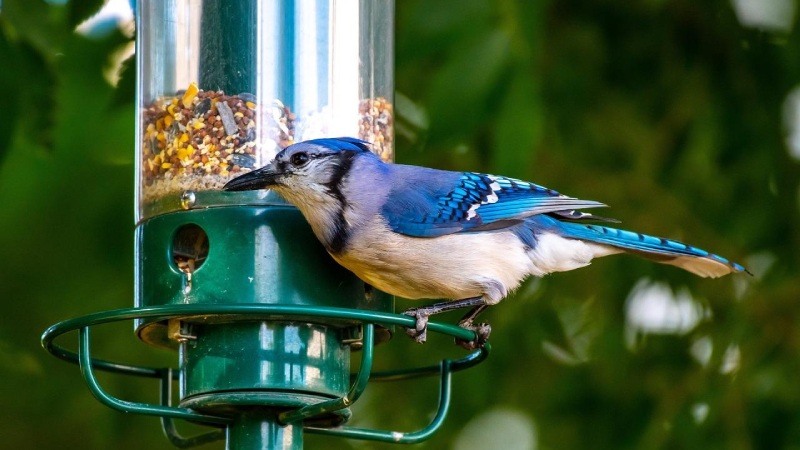
Blue jay bird is one of the magnificent birds, intelligent and full of life, possessing the power of provoking attention. This species is easily recognizable because of the bright blue plumage and a specific call; it attracts the attention of birders and ornithologists. These birds are beautiful to watch and exhibit specific actions and characteristics that pique an observer’s interest. Below are ten fun facts you might not know about the blue jay bird that will help you get an even closer look at the lives of these birds.
1. Their Feathers Aren’t Blue
The blue jay bird is famous for its brilliant blue feathers, but these feathers are not blue. Unlike most other birds, these birds lack blue pigments in their plumage. Blue is not a pigment but an outcome of light passing through the structure of the flight feather.
This is known as structural coloration and occurs due to the interference between the light and the tiny air pockets within the bird feathers. If you squash one like a blue jay feather, it turns grayish-brown because the component that reflects light is interfered with. This is quite interesting and shows that nothing in nature is without its unique twist in its structure.
2. Strong Family Bonds And Social Structure
These are social birds that have close-knit families throughout their lifetime. Bluejay birds are usually found as young adult birds; they often depend on their parents until they are ready to be alone.
Indeed, these birds are social and involve their family members in food gathering and assisting each other in the presence of birds of prey. This social behavior is paramount for juveniles as attaining independence involves grasping numerous survival techniques from the parents or siblings.
3. Skilled Mimics
An exciting feature of this bird is the manifestation of intelligence, which is why the blue jay bird can mimic the calls of other birds. They are famous for imitating hawks in particular kinds of calls. They may either call to other birds that there is a threat or drive out different species of birds from their territory.
In this case, imitation is advantageous to them in various ways, such as protecting them from predators and managing their food supply. Another view is that their act of mimicking hawks somehow means that they are evicted from the preferred feeding spot by other birds. This mimicry skill is the sub-illustration to the intelligent and versatile life of the blue jay bird.
4. Incredible Intelligence And Problem-Solving Skills
These are some of the most intelligent birds, and their problem-solving mania is comparable to some mammals. As their relatives’ crows, they are very curious and inventive. In the zoo, they were seen using tools to get food, which is unfamiliar to most animals worldwide.
They are also carnivorous birds and pack foods in small hidden places for future use, demonstrating how they structured their future. This intelligence enables them to live in various areas, so they are welcome to live in both rural and urban places.
5. Protective And Territorial Nature
The blue jay bird is known for being highly protective of its territory, especially during the nesting season. They will not hesitate to fend off any threat that may endanger their young ones, be it a big bird, a squirrel, or even some mammals. It cannot hunt for food during the day as it is brave when confronting strangers, which makes it make alarm calls and even attack to repel strangers from places where they have made their nests.
This behavior has significance and utility in their everyday existence to protect the young and commit to family and survival. They also show unexpected shrewdness when cooperating with other birds of different species on the premise of mutual defense against the rest of the birds, as may be observed.

6. Complex Communication Skills
They are wild birds with several kinds of calls and notes. They express these pitch variations with each other for alarm, mating, or astonishment. Their male calls are different and diverse, and they even employ some physical calls, such as raising crest feathers in various emotions and behaviors.
Not only is the blue jay, as with many other bird species, using vocalization for alarm calls, but it is also a segment of social communication; moreover, the birds sing “whisper songs,” which are relatively soft, subtle sounds that mated birds utter. This flexibility in communication brings out the aspects of intelligence and flexibility of the bird.
7. Omnivorous And Opportunistic Diet
The bluejay bird is known to be an omnivore, meaning it feeds on plant parts and animal-derived matter. These animals feed on seeds, nuts, fruits, insects, and small animals like frogs or bird eggs occasionally. They also like to eat acorns, which they preserve for the winter by hiding them in different places.
This habit of storing acorns has a crucial role in reforestation since they leave acorns behind when they are done with stashing them. This versatility is seen in their feeding habits and has made them one of the hardiest birds in North America regarding climate changes or even fab habitats.
8. Essential Role In Ecosystems
This is because by storing and burying acorns, various birds also help spread oak trees in the forests. Since they have to forget where they had buried some, these acorns grow into new oak trees, extending the canopy of a forest.
This behavior is incredibly noble because oaks are some of the keystone species and a source of food and shelter for many animals. While collecting food, they do not know that their actions help restore the environment, so they are beneficial birds.
9. Fascinating Migration Patterns
Most birds do not migrate, and their tendencies are poorly understood. While some blue jays fly south during winter, some remain on their home ground all year round.
This is surprising because some birds fly South even within the same family, while others are left at home. Scientists can only guess why only half of migration occurs, but they think that food scarcity and environmental conditions may have something to do with it.
10. Cultural And Symbolic Meaning
Bluejay bird is considered an image of courage and perseverance due to its unfearing and protective character. They are also considered to be omens or messengers or even to symbolize fidelity and verity by some Native American tribes.
Others believe it is a call to be assertive and speak out, which might be why some see the blue jay as a symbol of the opposite. Its bright look and singing disposition further strengthen its symbolism for confidence, giving it another exciting characteristic.
Conclusion
The bluejay bird is vivid, lovely, intelligent, unyielding, and even a social bird with its own ethological characteristics and pivotal place in the countryside ecosystem. From the bird having no ‘blue feathers’ to its importance in the regeneration of forests, the blue jay spurs a lot of curiosity amongst bird and nature lovers.